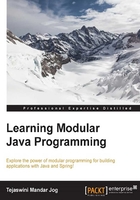
What this book covers
Chapter 1, Introducing Modular Programming, starts with a discussion about Enterprise application, its architecture, and its development. Enterprise application development is a team that activity faces many problems concerning collaboration between team members. We will introduce coordinated development and the tools involved in this chapter.
Chapter 2, Saying Hello to Java EE, involves a short warm up by discussing and developing a Java web application using Servlet-JSP. We will redevelop the application using a Spring to get startup gear as Spring MVC developer.
Chapter 3, Implementing the Presentation Layer, discusses the points that need to be taken care of when developing the most important layer of an application: the presentation layer. We will discuss how to develop the pages to incorporate data binding for business logic, as well as for presentation, using Spring MVC features.
Chapter 4, Talking to the Database, discusses Spring JDBC connectivity. Data collected from the user and data to be used in the business logic need to be persisted. We will also cover Spring DAO support persistency. We will then move on a step and introduce Hibernate, the ORM technology, and its integration with Spring. We will also cover unit testing to make sure our code is working fine.
Chapter 5, Developing the Business Layer, discusses the development of the most important layer of an application—the business layer—and the communication between the layers. An application needs to be developed by following a number of business rules.
Chapter 6, Testing Your Application, explains that the modules developed by the developer should produce the correct result. To ensure the correctness of the code in this chapter, we will cover the basics of testing with the help of the V module. We will also cover integration testing with JUnit and Mockito.
Chapter 7, Securing the Application, discusses why and how to secure the application. In an application, there are certain modules that are open and available to all, and some that are restricted. We will apply the Spring security module to secure the Spring MVC application with the help of basic and form based security.
Chapter 8, Versioning and Deploying, shows us how to collaborate on the application, which has been developed in parts, or by different team members simultaneously. In this chapter, we will set up and integrate Tortoise SVN as a versioning tool used to collaborate on the code. We will also discuss the creation of repositories, users, and setting access rules for Collabnet and Visual SVN servers.